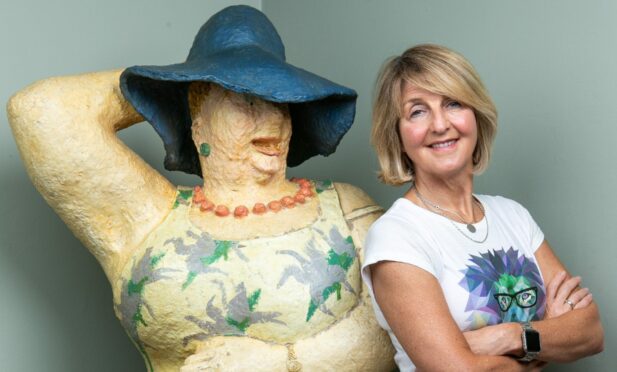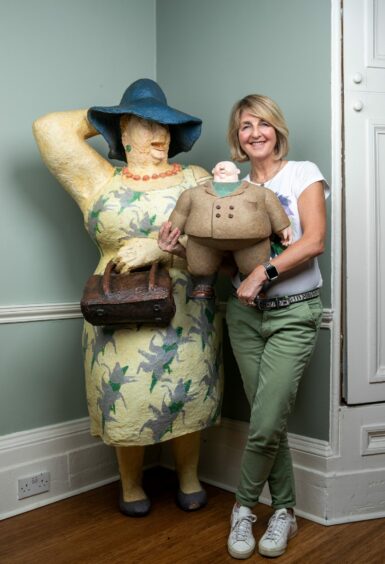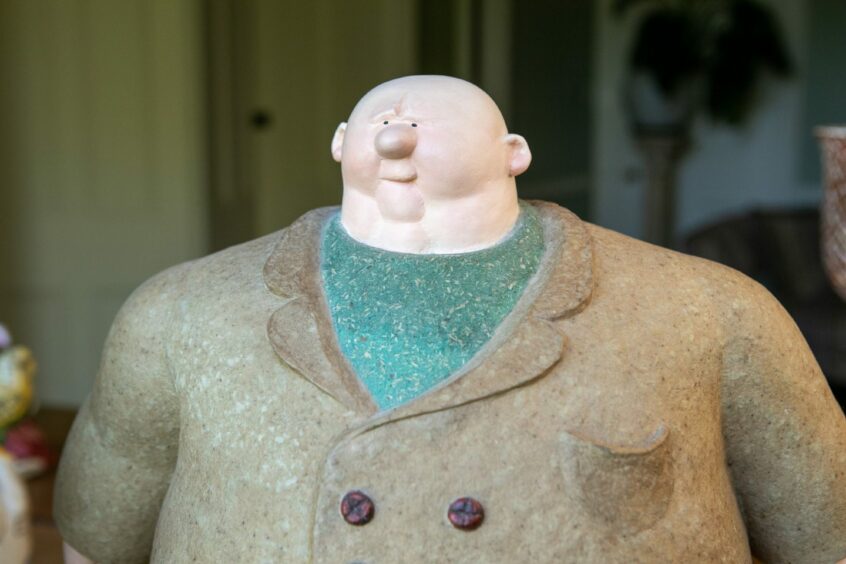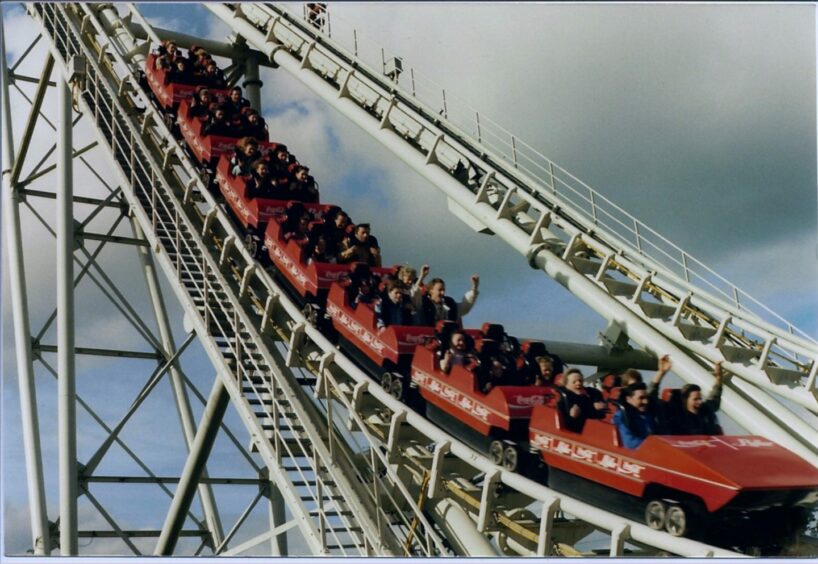
She’s 7ft tall, overweight and sunburned… and she has been presenter Kaye Adams’ constant companion for 35 years.
Those who visited the Glasgow Garden Festival in 1988 might remember bumping into a larger-than-life pair of papier-mache holidaymakers hiding from the sun on the banks of the Clyde.
The sculpture was one of hundreds of well-remembered art installations to feature in the festival, which ran for six months from April 1988.
Many of the items from the botanical fiesta, which included contributions from renowned artists like George Wyllie, Stan Bonnar and Eduardo Paolozzi, have been relocated by a team of social historians behind the website After The Garden Festival.
They’ve located many forgotten items, some of which have been found as far away as Japan and America.
But Kaye’s “big Scottish wummin” is much closer to home, living with the broadcaster and her family in their home in the west end of the city.
Adopting Irene
The presenter made the decision to adopt artist Mhairi Corr’s sculpture in the days following the festival site’s clearance in the late-1980s, giving her the name Irene.
She said: “I had just joined STV and moved to Glasgow for the first time after working in London and Birmingham. I was sent out to the Garden Festival what felt like every day, covering all sorts of stories all over the site.
“Certain things stood out to me, and one of them was Irene. I loved this big fat lady and, when I read they were selling off exhibits, I swooped in and bought her in a warehouse in Hillington. It was destiny that we were meant to be together.”
Kaye named her robust companion after a workmate.
She said: “I called her Irene after someone I used to work with who I will never disclose. People thought I was barmy. At that time I didn’t have my own house, I was renting. I was in my mid-20s and I moved around quite a bit, flat-sharing. But, wherever I went, renting a room or a flat, it was me and Irene. If they couldn’t take Irene, I wasn’t moving in.
“She was in the window of my first flat in Hyndland Road. I can only imagine what people walking along the street thought.”
Now Irene has become a central part of Kaye’s domestic set-up.
“She came along before the kids did, so they have no say about her,” she said.
Kaye even tracked down artist Mhairi Corr, commissioning a companion piece for Irene to mark the presenter’s 40th birthday.
She said: “Irene and her bloke had been a prototype for the style she was developing, which she had refined quite a bit since. She was making much smaller figures now, more refined. So, for my 40th I found Mhairi and commissioned smaller figure called Otto. And I have him on the piano, beside Irene.”
After the Garden Festival
Designer Lex Lamb is one of a small team of social historians running the After The Garden Festival website, which aims to locate hundreds of forgotten items from the festival.
The whereabouts of scores of items – from the Coca-Cola Roller, mini steam train and Clydesdale Bank Tower to art by revered Scottish artists like sculptor George Wyllie – have been recorded.
Lex said: “The story of Irene’s long-term live-in relationship is representative of the depth of affection that the Garden Festival generated.
“From benches to merchandise to still-flourishing trees and shrubs, anyone that was able to take away a piece of this summer tends to be attached to it, and the number of people that have been in touch with After the Garden Festival to show off their treasured item is amazing. How many events could you say the same about?”
Coca-Cola Roller was highlight for 4.5m people at jamboree
The 1988 Glasgow Garden Festival was originally conceived to open in 1989, but was brought forward a year to create continuity with the Empire Exhibition of 1938 and the International Exhibition of 1888.
Following festivals in Liverpool and Stoke on Trent, it was the third of five jamborees, seen by many to have been the most successful.
A key developmental objective for the Garden Festivals project was to revive scarred post-industrial areas, and revitalise local economies. A huge temporary park celebrated Scottish landscape and culture, rolling across a 120-acre former shipyard site on the south side of the Clyde, where BBC Scotland, STV, the Glasgow Science Centre and Tower now stand.
It was visited by 4.5 million people, many more than expected, with 120,000 buying season tickets.
Among the key attractions remembered by millions was the Coca-Cola Roller, which now resides at a theme park in Lowestoft, Suffolk.
As one of the key graphic designers with site creators Gillespies, Stephen Cameron is responsible for the name behind the festival’s most popular ride.
He said:“When it was mentioned that there was going to be a rollercoaster, I very flippantly suggested that if they were looking for a sponsor they should call it the Coca-Cola Roller, because of the word-play.
“Coca-Cola were subsequently approached and asked to back it, and they did.
“Sometimes I’m ashamed to say it, and other times I’m quite proud to be part of history. It’s one the things people remember most – but I never went on it!”

Enjoy the convenience of having The Sunday Post delivered as a digital ePaper straight to your smartphone, tablet or computer.
Subscribe for only £5.49 a month and enjoy all the benefits of the printed paper as a digital replica.
Subscribe © Andrew Cawley
© Andrew Cawley © Andrew Cawley
© Andrew Cawley